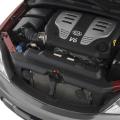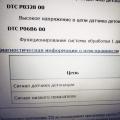State standard of the Russian Federation GOST R 50577-93
"Signs of state registration vehicles. Types and main dimensions. Technical requirements"
(adopted and put into effect by the decree of the State Standard of the Russian Federation of June 29, 1993 N 165)
With changes and additions from:
License plates for vehicles. Types and main sizes. Technical requirements
Introduced for the first time
1 area of \u200b\u200buse
This standard defines the types and main dimensions, as well as technical requirements for state registration plates (hereinafter - registration plates) installed on vehicles.
The requirements of this standard are mandatory.
1B - for passenger taxis, vehicles equipped for the carriage of more than eight people (except for cases when these carriages are carried out on orders or to meet their own needs legal entity or an individual entrepreneur)
2 - for car trailers (including rear trailers for motorcycles and scooters) and semi-trailers;
3 - for tractors, self-propelled road-building and other machines and trailers (semi-trailers) for them;
4 - for motorcycles, scooters, mopeds and snowmobiles.
3.2.2 Group 2 vehicles
5 - for cars, trucks, vans and buses;
6 - for car trailers (including rear trailers for motorcycles and scooters) and semi-trailers;
7 - for tractors, self-propelled road-building and other machines and trailers (semi-trailers) for them;
8 - for motorcycles, scooters, mopeds and snowmobiles.
(Modified edition, Amendment N 1).
3.2.3 Vehicles of the 3rd group
The following types of registration plates are installed:
9 - for cars of heads of diplomatic missions;
10 - for cars, trucks, vans and buses of diplomatic missions, consular offices, including those headed by honorary consular officials, international (intergovernmental) organizations and their employees accredited by the Ministry of Foreign Affairs Russian Federation.
3.2.4 Vehicles of the 4th group
The following types of registration plates are installed:
15 - for cars, trucks, utility vehicles, buses, car trailers and semi-trailers;
16 - for motorcycles, scooters, mopeds and snowmobiles;
17 - for cars, trucks, utility vehicles, buses and other vehicles of military units and formations under the jurisdiction of the Russian Federation;
18 - for tractors, self-propelled road-building and other machines and trailers (semi-trailers) for them;
19 - for cars, trucks, vans, buses and other vehicles that finally leave the Russian Federation, as well as for other cases determined by the Ministry of Internal Affairs of the Russian Federation.
(Modified edition, Rev. N 1, 2).
3.2.5 Group 5 vehicles
The following types of registration plates are installed:
20 - for cars, trucks, vans and buses;
21 - for car trailers (including rear trailers for motorcycles and scooters) and semi-trailers;
22 - for motorcycles.
(Introduced additionally, Rev. N 2).
3.3 The structure of registration plates should be as follows:
Type (one-line) - M 000 MM 55 or M 000 MM 555; - type 1B (one-line) - MM 000 55 - type (one-line) - MM 0000 55; - type (two-line) - 0000 MM 55; - type (two-line) - 0000 MM 55; - type (one-line) - 0000 MM 55; - type (one-line) - MM 0000 55; - type (two-line) - 0000 MM 55; - type (two-line) - 0000 MM 55; - type (one-line) - 222 MM 0 55; - type (one-line) - 222 M 000 55; - type (one-line) - MM 000 M 55; - type (three-line) - "TRANSIT" MM 55 0000; - type (three-line) - MM 55 0000 "TRANSIT"; - type (three-line) - MM 55 "TRANSIT" 0000; - type (one-line) - Т MM 000 55; - type (one-line) - M 0000 55; - type (one-line) - 000 М 55; - type (two-line) - 0000 M55, where 0 and M are a number and a letter, respectively, meaning the number and series of the vehicle registration plate; 2 - number of the code used on registration plates to designate vehicles of accredited diplomatic missions, consular offices, international (interstate) organizations; 5 - digit of the code of the region of the Russian Federation, used on the registration plates of vehicles (hereinafter - the region of registration); T - the first letter of the word "TRANSIT", meaning the registration plate of a vehicle temporarily admitted to road traffic.
(Modified edition, Rev. N 1, 2).
3.4 On registration plates of types 1B, 4-6, 8-10, 15-22 there should be an inscription "RUS". Registration plates of types 16-18 must bear the inscription "TRANSIT". On registration plates of types, and additionally the presence of the image of the State flag of the Russian Federation is allowed.
Note - The image of the State Flag of the Russian Federation should be a rectangle with equal horizontal stripes: the upper stripe white, average - of blue color and the bottom is red.
(Modified edition, Amendment N 2).
3.5 The main dimensions of the registration plates, the location of the inscriptions "RUS" and "TRANSIT", numbers, letters and edging on the front side of the registration plates, the dimensions and location of the holes for fixing the registration plate on the vehicle must correspond to those indicated in Figures A.1-A.22 Appendix A. If there are types and images of the State Flag of the Russian Federation on the signs, the inscription "RUS" is placed in accordance with Figure A.23 of Appendix A.
Notes
3 Requirement is not required for RUS.
3.8 The shape and nature of the outline of numbers and letters used on registration plates (types 1-10,, 19-22) must correspond to Figures B.1 and C.1 of Appendices B and C, and the thickness of the lines of numbers and letters (including the thickness of the edging ) - the values \u200b\u200bgiven in Table 1. The rest of the dimensions are set in the design documentation for registration plates, agreed with the Ministry of Internal Affairs of the Russian Federation.
Table 1
Sizes of numbers and letters of registration plates
In millimeters
Numbers and letters on the front side of the registration plate of types 16-18 must be executed in the ZhR5 font in accordance with GOST 3489.2, and on the reverse side - in the Bl3 font in accordance with GOST 3489.17.
3.5-3.8 (Modified edition, Rev. N 1, 2).
JT16 3.9 Limit deviations of dimensions - ------ according to GOST 25346.2
Note - It is allowed to manufacture registration plates of the type installed on vehicles operated only outside highways general use, without reflective coating.
(Modified edition, Rev. N 1, 2).
4.7 Requirements for the coverage of the field of registration plates (except for signs with a reflective coating and signs made by a typographic method)
4.7.2 The strength of the coating upon impact is not less than 40 cm in accordance with GOST 4765.
4.7.4 The weather resistance of the coating - in accordance with GOST 9.401 for the II type of atmosphere in accordance with GOST 15150, while maintaining the protective properties in accordance with GOST 9.407 no more than 1 point and decorative properties no more than 2 points must be at least three years under U1 operating conditions and at least two years in the operating conditions of ХЛ1 according to
Entered into force by the order of the Gosstandart of Russia dated May 22, 2009 N 164-st, this annex is amended, entered into force on November 1, 2009.
Appendix I
(required)
Requirements for the installation of state registration plates on vehicles
With changes and additions from:
I.1 Each vehicle must be provided with a place for the installation of the following registration plates (except for type 16-18):
One front and one rear - on cars, trucks, utility vehicles and buses;
One back - on other vehicles.
I.2 The place for the installation of the registration plate should be a flat vertical rectangular surface and should be chosen in such a way as to exclude obstruction of the sign by the structural elements of the vehicle, pollution during operation of the vehicle and difficulty in reading. At the same time, registration plates should not reduce the angles of the front and rear overhangs of the vehicle, cover external light and signal devices, protrude beyond the side clearance of the vehicle.
I.3 The front registration plate should be installed generally along the axis of symmetry of the vehicle. It is allowed to install the front registration plate to the left of the vehicle's axis of symmetry in the direction of vehicle movement.
I.4 The place of installation of the rear registration plate must ensure that the following conditions are met.
I.4.1. The registration plate must be installed along the axis of symmetry of the vehicle or to the left of it in the direction of travel.
I.4.2. The registration plate shall be installed perpendicular to the longitudinal plane of symmetry of the vehicle with a deviation of not more than 3 °.
I.4.3. The registration plate on the vehicle must be located perpendicular to the reference plane of the vehicle with a deviation of not more than 5 °.
Note - If the design of the vehicle does not allow the installation of registration plates perpendicular to the reference plane of the vehicle, then for registration plates, the height of the upper edge of which is not more than 1200 mm, this angle may be increased to 30 ° if the surface on which the sign is installed is facing upwards, and up to 15 ° if the surface is facing down.
I.4.4 The height of the lower edge of the rear registration plate from the reference plane of the vehicle must be at least 300 mm, for motorcycles, scooters, mopeds and snowmobiles - at least 200 mm, the height of the upper edge of the plate - not more than 1200 mm.
Notes
1 If the design of the vehicle does not allow to ensure the height of the upper edge of the registration plate at a height of not more than 1200 mm, an increase in size up to 2000 mm is allowed.
2 Measurement of the height of the registration plate from the reference plane of the vehicle must be carried out on the vehicle with unladen weight.
I.4.5 The registration mark must be visible in a space bounded by the following four planes: two vertical and two horizontal, touching the edges of the mark within the angles of visibility indicated in figure 3.1.
I.4.6 The relative location of the registration plate and the license plate lamp (s) on the vehicle must comply with GOST R 41.4.
I.4.7 The registration plate must be installed in such a way that in the dark it is possible to read it from a distance of at least 20 m when illuminated by a standard lantern (lanterns) of illumination of the vehicle sign.
Note - The requirement does not apply to the inscriptions "RUS" and "TRANSIT", as well as to the image of the flag of the Russian Federation.
I.5 For fastening registration plates, bolts or screws with heads having the color of the mark field or light electroplated coatings should be used.
Fastening of signs with frames is allowed. Bolts, screws, frames must not obstruct or distort the inscription "RUS" on the registration plate, the image of the State Flag of the Russian Federation, Letters or numbers.
It is not allowed to cover the sign with organic glass or other materials.
Drilling on the registration plate is prohibited additional holes for attaching the sign to the vehicle or for other purposes.
In the event of a mismatch in the coordinates of the license plate bore holes with the coordinates of the vehicle bore holes, the signs must be fastened through transitional structural elementsensuring the fulfillment of the requirements of I.2-I.4.
I.6 Registration plates of types 16-18 should be installed:
On passenger cars and in buses - one on the front and one on the rear windshields inside the passenger compartment (cabin) to the right of the longitudinal plane of symmetry in the direction of movement of the vehicle;
On trucks and tractors - one sign on the front windshield inside the cab to the right of the longitudinal plane of symmetry in the direction of movement of the vehicle.
License plates issued for motorcycles and trailers must be kept by the drivers.
I.7 Type registration plates must be installed on cars, trucks, buses (one in front and one behind) and trailers (one behind) on the regular places of installation of registration plates of these vehicles.
Reliable fastening of registration plates of the type must be ensured during the entire period of their validity using, if necessary, frames or other transitional structural elements.
Appendix I (Introduced additionally, Amendment N 2).
Previously, it was necessary to change registration plates every time. In addition, we were obliged to replace the numbers when changing the region of residence. Now the situation has changed: without numbers, we only get new cars in a car dealership, used cars are transferred to new owners with the same numbers.
In order not to get penalties, you need to consider the following: Part 2 of Article 12.2 of the Administrative Offenses Code of the Russian Federation provides for a penalty in the form of a fine of 5,000 rubles or deprivation of the right to drive (from one to three months) for driving a car without numbers, or for driving with registration marks set in places not provided for this.
Where to fix the numbers?
The places where registration plates are installed on vehicles are indicated by the manufacturer. These are usually stampings on the front bumper and trunk lid or rear bumper.
If you bought new car, then, having put it on record, you need to set the numbers before starting the movement. Some car owners, due to the lack, for example, of a tool (special frames or the same self-tapping screws), fix the numbers in the cabin under the windscreen and rear windows... This should not be done in any case. If you get caught, it will justly hold you accountable under this article. Therefore, before going to the traffic police, you need to prepare everything you need to fix the numbers.
But what if there are no specially marked places on the car? This occurs, for example, if a “non-native” front bumper is installed on the car, on which there is no place at all for fixing the license plate. And it happens that the car is not officially sold with us and the location of the rear number plate is not designed for the shape of Russian numbers. In the first case, you can fix the number directly in the center or on the left side of the bumper with ordinary screws.In the state standard “Signs of state registration vehicles. Types and basic sizes. Technical requirements ”it is written that the front number must be set along the axis of symmetry of the vehicle. However, it also contains the ability to install front sign and to the left of the vehicle's axis of symmetry in the direction of travel. To be clear, this is any place on the front bumper from the center to the end of the bumper on the left (as viewed from the driver's seat).
By the way, on some models (or Alfa romeo) mounts for front room arranged asymmetrically straight from the factory.Similarly, you can install the registration plate on the rear bumper. In this case, the number is set to the left of the vehicle axis. On serious off-road vehicles, numbers are often installed not on the bumper, but on the roof, so that they are not washed away when crossing. This is also allowed, the main thing is that the height from the base of the car to the sign does not exceed two meters.
If you have, for example, an "American" (their rear numbers are square), you can install the sign in a regular place using special adapters. GOST allows it. The main thing to consider here are the following points. The number must be readable in the dark. So, you need to provide backlighting. If you can use the standard room illuminators, that's good. And in cases where the number on the adapters is too far out, you will have to use special backlit frames.
How to fix?
Today the most common way of fastening is called "forever". This is when the number is tightly screwed with screws or bolts. The main requirement here is that the heads of the self-tapping screws should be light or in the color of the sign field. At the same time, they should not obstruct or distort letters and numbers.
The next method, which is not inferior to the previous one in popularity, is the installation of numbers in special frames. As a rule, car owners do not have any questions here. The frames are screwed to the bumper or trunk lid with self-tapping screws, and the signs themselves are fixed within the frames with special latches.
If you are afraid that the number may get lost, additionally attach it to the frame with plastic clamps (light).
Became popular due to the appearance paid parking different kinds can also be used. The GOST indicates that it is permissible to fix the number with frames. At the same time, it is not said which frames can be used and which cannot. The only limitation is that you cannot cover the room with plexiglass or similar protective devices.
It is not allowed to use bolts with reflective caps when fixing the number plate. For this, you can get a 500-ruble fine under Part 1 of Article 12.2 of the Administrative Code of the Russian Federation.
The registration number must be fixed in such a way that it is upright, not looking "at the floor" or "at the sky". And in the dark, all numbers and letters on the number must be distinguishable from a distance of at least 20 meters under standard lighting.
According to GOST R 50577-93 “Signs of state registration vehicles. Types and basic sizes. Technical requirements":
I.3. The front registration plate should be installed, as a rule, along the axis of symmetry of the vehicle. It is allowed to install the front registration plate to the left of the vehicle's axis of symmetry in the direction of vehicle movement.
I.4. The installation location of the rear registration plate must ensure that the following conditions are met:
I.4.1. The registration plate must be installed along the axis of symmetry of the vehicle or to the left of it in the direction of travel.
I.4.2. The registration plate must be installed perpendicular to the longitudinal plane of symmetry of the vehicle with a deviation of not more than 3 °.
I.4.3. The registration plate on the vehicle must be located perpendicular to the reference plane of the vehicle with a deviation of not more than 5 °.
Note. If the design of the vehicle does not allow the installation of registration plates perpendicular to the reference plane of the vehicle, then for registration plates, the height of the upper edge of which is not more than 1200 mm, this angle may be increased to 30 ° if the surface on which the sign is installed is facing upwards, and up to 15 ° if the surface is facing down.
The front and rear numbers should be located either along the axis of symmetry of the car, or to the left of it in the direction of travel (closer to the center of the road). If the numbers are set to the right of the symmetry axis, this will be a violation of GOST.
Installation sites are required:
AND 2. The place for the installation of the registration plate must be a flat vertical rectangular surface and should be chosen in such a way as to exclude obstruction of the plate by the structural elements of the vehicle, contamination during operation of the vehicle and difficulty in reading. At the same time, registration plates should not reduce the angles of the front and rear overhangs of the vehicle, cover external light and signal devices, protrude beyond the side clearance of the vehicle.
Fastening of license plates.
GOST contains requirements for bolts with which numbers must be attached:
I.5. For fastening registration plates, bolts or screws with heads having the color of the mark field or light electroplated coatings must be used.
Fastening of signs with frames is allowed. Bolts, screws, frames must not obstruct or distort the inscription "RUS" on the registration plate, the image of the State Flag of the Russian Federation, letters or numbers.
(as amended by Amendment No. 3, approved by the Order of Rostekhregulirovanie from 22.05.2009 No. 164-st)
It is not allowed to cover the sign with organic glass or other materials.
It is prohibited to drill additional holes on the registration plate for attaching the plate to the vehicle or for other purposes.
In the event of a mismatch in the coordinates of the registration plate bore holes with the coordinates of the vehicle bore holes, the signs must be fastened through transitional structural elements that ensure the fulfillment of the requirements of I.2 - I.4.




